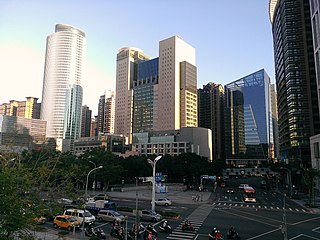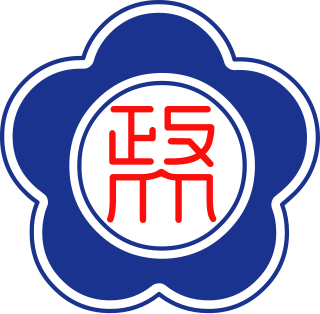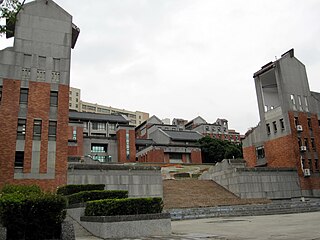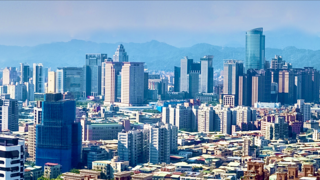
Libraries in Taipei include:

Libraries in Taipei include:
| Wikimedia Commons has media related to Libraries in Taipei . |

Taipei, officially Taipei City, is the capital and a special municipality of Taiwan. Located in Northern Taiwan, Taipei City is an enclave of the municipality of New Taipei City that sits about 25 km (16 mi) southwest of the northern port city of Keelung. Most of the city rests on the Taipei Basin, an ancient lakebed. The basin is bounded by the relatively narrow valleys of the Keelung and Xindian rivers, which join to form the Tamsui River along the city's western border.

National Taiwan University is a national university located in Taipei, Taiwan. NTU has been considered the most comprehensive university on the island. It consists of 11 colleges, 56 departments, 133 graduate institutes, over 60 research centers and a school of professional education and continuing studies.
The Taipei Times is the only printed daily English-language newspaper in Taiwan, and the third established there. Online competitors include the state-owned Focus Taiwan and Taiwan News; The China Post was formerly a competitor but today is mostly non-operational. Established on 15 June 1999, the Taipei Times is published by the Liberty Times Group, which also publishes a Chinese-language newspaper, the Liberty Times, Taiwan's biggest newspaper by circulation, with a pro–Taiwan independence editorial line.

New Taipei City is a special municipality located in northern Taiwan. The city is home to an estimated population of 4,008,113 as of 2021, making it the most populous city of Taiwan, which is also the second largest special municipality by area, behind Kaohsiung. New Taipei City completely encloses the city of Taipei and neighbours Keelung to the northeast, Yilan County to the southeast, and Taoyuan to the southwest. Banqiao District is its municipal seat and biggest commercial area.

Neihu District is a district of Taipei City, Taiwan. Neihu means "inner lake." The older name originates from the Ketagalan word Tayour, meaning woman's head ornament.

Zhongzheng District is a district in Taipei. It is home to most of the national government buildings of the Republic of China (Taiwan), including the Presidential Office, the Executive Yuan, the Control Yuan, the Legislative Yuan, the Judicial Yuan and various government ministries.

Beitou District is the northernmost of the twelve districts of Taipei City, Taiwan. The historical spelling of the district is Peitou. The name originates from the Ketagalan word Kipatauw, meaning witch. Beitou is the most mountainous and highest of Taipei's districts, encompassing a meadow with rivers running through the valley which have abundant steam rising from them; the result of geothermal warming. The valley is often surrounded by mist shrouding the trees and grass. Beitou is famous for its hot springs. In March 2012, it was named one of the Top 10 Small Tourist Towns by the Tourism Bureau of Taiwan.

Taipei Medical University in Taiwan is located in Taipei's Xinyi District. Founded as Taipei Medical College in 1960, it was renamed as Taipei Medical University in 2000.

National Chengchi University is a Taiwan-based national research university. The university is also considered as the earliest public service training facility of the Republic of China. First established in Nanjing in 1927, the university was subsequently relocated to Taipei in 1954. It is considered to be one of the most prestigious and prominent universities in Taiwan. The university, abbreviated as NCCU, specializes in arts and humanities, mass media, linguistics and literature, social sciences, economics, management, politics, and international affairs programs. It is the only publicly funded university in Taiwan which provides courses in journalism, advertising, radio and television, diplomacy, and several languages which are not taught at other institutions in Taiwan. The name Chengchi means governance or politics, and refers to its founding in 1927 as a training institution for senior civil service for the Nanjing Nationalist government of the Republic of China. The university has strong ties with academic institutions like Academia Sinica, National Yang Ming Chiao Tung University, National Taiwan University and National Palace Museum. NCCU is a member of the University System of Taiwan.

National Taipei University, founded in 1949, is a national university in Taiwan which specializes in law, business, humanities, and social sciences. Before 2000, the University was named the College of Law and Business, National Chung Hsing University. The university's main campus is in Sanxia District, New Taipei, Taiwan. Two other campus and education center are in Zhongshan District, Taipei, Taiwan.

The Taipei National University of the Arts is a national university in Guandu, Beitou District, Taipei, Taiwan.

National Taiwan University of Science and Technology, or Taiwan Tech (臺科大), is a public university located in Taipei, Taiwan. Taiwan Tech was established in 1974 as the National Taiwan Institute of Technology (國立臺灣工業技術學院), as the first and the leading higher education institution within Taiwan's technical and vocational education system. Taiwan Tech is one of Asia's 10th rank as the best institute in science and technology.

The Ministry of Education (MOE) is the ministry of the Republic of China (Taiwan) responsible for incorporating educational policies and managing public schools.

The National Central Library is the national library of the Republic of China (Taiwan), which is located at No. 20, Zhongshan S. Rd., Zhongzheng District, Taipei City 10001, Taiwan. It will soon have a subsidiary called Southern Branch of the National Central Library & National Repository Library.

The following outline is provided as an overview of and topical guide to Taiwan:
Articles related to Taiwan include:

Airiti Incorporation headquartered in Taipei, Taiwan, is a Chinese e-content provider of Chinese academic e-journals, Taiwanese academic e-journals, classical art images to more than 450 libraries in 2006 and has extended to more than 72,000 libraries in 112 countries and territories around the world.

Banqiao District is a district and the seat of New Taipei City, Taiwan. It has the third-highest population density in Taiwan, with over 24,000 inhabitants per square kilometre (62,000/sq mi). Until the creation of New Taipei City, Banqiao was an incorporated county-administered city and the former seat of Taipei County.
The architecture of Taiwan can be traced back to stilt housing of the aborigines in prehistoric times; to the building of fortresses and churches in the north and south used to colonize and convert the inhabitants during the Dutch and Spanish period; the Tungning period when Taiwan was a base of anti-Qing sentiment and Minnan-style architecture was introduced; in Qing dynasty period, a mix of Chinese and Western architecture appeared and artillery battery flourished during Qing's Self-Strengthening Movement; During the Japanese rule of Taiwan, the Minnan, Japanese and Western culture were main influencers in architectural designs and saw the introduction and use of reinforced concrete. Due to excessive Westernization as a colony, after the retrocession of Taiwan to the Republic of China in 1945 from Japan at the end of World War II, Chinese classical style became popular and entered into international mainstream as a postmodern design style. Today, Taiwanese architecture has undergone much diversification, every style of architecture can be seen.